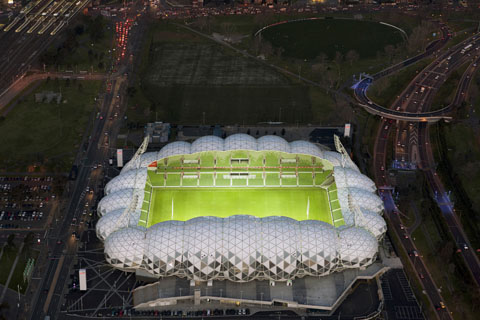Listen Out Festival Temporary Tensile Canopy - LSAA 2013 Award of Excellence (Cat 6, #6512)
Entrant: Tensys Engineers Pty Ltd
- Location: Royal Botanical Gardens, Melbourne
- Client: Listen Out Festival, Melbourne 2013 - Completion Date: 2013
Judges Comments:
"Beautifully resolved on all levels."
"An innovative, imaginative and thoroughly engaging project. So right for purpose - a canopy under which to shelter in a park while listening to music. Great colour. Joyful work that captures the spirit and essence of lightweight construction."
PROJECT DESCRIPTION:
Temporary structure for the Listen Out Music Festival at the Royal Botanical Gardens in Melbourne.
Experimental work exploring the different tensile anticlastic forms.This structure is an end result of conceptual and digital studies carried out by MADA students of a cloud. The functional brief was to provide a temporary shading structure for the patrons of the festival covering a 5m x 5m footprint.
DESIGN / FABRICATION / INSTALLATION BRIEF
The design brief supplied by the Listen Out Music Festival was to create a temporary structure that would serve to shade and allow for festival patrons to rest, relax and enjoy the surrounds. In response to these instructions, a decision was made to construct a lightweight pavilion from fibreglass rods coupled with a fabric membrane that would not only address the need for shelter but also accommodate individuals who wish to unwind and collect themselves.
STRUCTURAL SYSTEMS
A major constraint of constructing within Melbourne’s botanical gardens was the inability to puncture into the grounds surface. In order to work with this constrain, the pavilion was designed to utilise the fibreglass rods inherent tensile properties and create a structure that would be free standing and also minimise point loads onto the ground.
Through prototyping, it was evident that the individual rods themselves would not provide the rigidity required for the stresses of a music festival. This led to creation of pre-fabricated trichord truss modules (aiding not only in providing rigidity and stiffness) but also transportation and assembly.
MATERIALS
The fibreglass rods were sourced from Permex a company based in Sydney and are created by pulling a fibre/resin matrix through a heated die in which gelation and cure takes place. They were adopted due to their light-weight nature and inherent ability to flex and be manipulated to create a curvilinear frame. Conventionally fibreglass rod's sourced from Permex are used as Sail Battens on a range of different sail boats in order to give form and rigidity to the boats sail
The tensile fabric used is a nylon lycra material. This was sewn together and deformed to create the anticlastic stressed forms anchored to the structural fibreglass rods and trusses.
FABRICATION
The pavilion required five connection components to be fabricated prior to its construction. A stainless steel splice join was required to connect the fibreglass rods to the appropriate length. Stainless steel strapping then formed the basis of the structural connections, used with a rubber lining to fix two rods to each other and with a plywood spacer to connect three and six rods together.
The nylon lycra fabric panels were lashed to structure using nylon cord, threaded through eyelets in the hem of each panel.
COLLABORATION, CONSTRUCTION AND MAINTENANCE
The project is the result of a close interdisciplinary collaborative design process between the designers and fabricators (Architecture Masters students), an artist and the engineer. Extensive experimental and iterative prototyping and scaled models were created throughout the design and fabrication process to create the final form and structure. Improvements and refinements were adopted at each stage of the design and fabrication process.
Credits:
- Architect: Tim Schork MADA, Monash University
- Structural Engineer: Tensys Engineers
- Others: Callum Morton (MAP)
- Builder: Monash Art Design & Architecture (MADA)
- Fabricator: MADA






